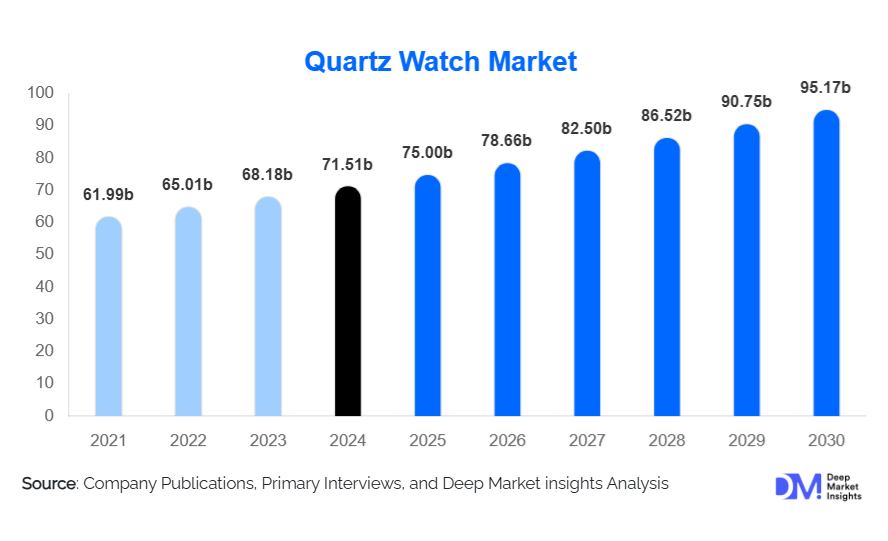According to deep market insights, the global quartz watch market, valued at USD 71.51 billion in 2024, is set to witness steady growth, projected to reach USD 75 billion in 2025 and further expand to USD 95.17 billion by 2030 at a CAGR of 4.88% during the forecast period. Affordability, technological innovation, and rising consumer demand for fashionable yet functional timepieces are fuelling the market’s momentum.
Quartz watches, celebrated for their precision, low maintenance, and mass appeal, continue to dominate the global wristwatch industry despite competition from mechanical watches and smartwatches. The market’s resilience lies in its ability to evolve—adapting to shifting lifestyle trends while maintaining affordability for consumers across diverse demographics.
Key Market Insights Driving Growth
-
Analog quartz watches lead the market due to their timeless aesthetics, reliability, and affordability. Innovations such as solar charging and water resistance are enhancing their utility and appeal.
-
Mid-range quartz watches (USD 100–500) dominate globally, driven by the growing middle class in Asia-Pacific and Latin America. Consumers are drawn to the balance of brand value, durability, and price.
-
Online retail has emerged as the top distribution channel, accelerated by e-commerce, D2C brand strategies, and influencer-led marketing.
-
Regional trends highlight Asia-Pacific as the fastest-growing market, while North America and Europe maintain strong heritage-driven demand. Meanwhile, Latin America and the Middle East are showing robust growth, supported by gifting traditions and urban middle-class adoption.
Latest Market Trends
-
Vintage Revival Among Gen Z
A resurgence of vintage quartz designs is captivating younger audiences. Iconic brands like Seiko and Casio are reissuing classic models that blend nostalgia with modern durability. Social media influencers and celebrities are amplifying this retro wave, making vintage-style quartz watches a fashionable staple among Gen Z. -
Integration of Smart Features
Hybrid quartz models are bridging the gap between tradition and technology. Watches equipped with fitness tracking, notifications, and Bluetooth connectivity are gaining traction among professionals and millennials who value analog craftsmanship combined with digital convenience. Brands such as Fossil, Citizen, and Casio are leading this hybrid transformation.
Market Drivers
-
Growing Demand for Solar-Powered Quartz Watches
Eco-conscious consumers are fuelling demand for solar-powered models that reduce battery waste and ensure reliability. For instance, the newly launched Tissot PRC 100 Solar Quartz charges in just ten minutes of sunlight and delivers a 14-month reserve, underscoring innovation in energy-efficient design. -
Affordability and Accessibility
Quartz watches’ affordability and accuracy make them a natural choice for students, young professionals, and first-time buyers. Established brands such as Casio, Timex, and Titan continue to expand their collections, reaching new audiences in Tier 2 and Tier 3 cities globally.
Market Challenges
The quartz segment faces rising competition from both smartwatches, which appeal to tech-driven consumers, and mechanical watches, which attract luxury buyers seeking heritage and craftsmanship. Additionally, quartz models often struggle to gain recognition in premium segments, where luxury is strongly associated with artisanal watchmaking.
Emerging Opportunities
-
Celebrity Endorsements
Collaborations with high-profile figures are elevating quartz watches into the luxury fashion spotlight. Recently, Chopard’s Ice Cube Secret collection, fronted by supermodel Bella Hadid, redefined quartz as a symbol of chic sophistication. -
Integration of Wellness Features
Quartz models with subtle wellness functions—such as step counters, hydration reminders, or UV alerts—are carving out a niche. Unlike bulky smartwatches, these designs offer elegance with added utility, appealing to wellness-conscious consumers.
Regional Highlights
-
North America & Europe: Steady growth with fashion-driven buyers and strong e-commerce penetration. Seasonal demand spikes during events like Black Friday and Valentine’s Day.
-
Asia-Pacific: Fastest growth rate, supported by young, urban buyers in China, India, and Japan. Online retail platforms and influencer marketing play a key role.
-
Middle East & Africa: Strong demand for designer quartz watches in gifting traditions, especially during cultural celebrations.
-
Latin America: Middle-class consumers in Brazil, Mexico, and Argentina drive demand for stylish, budget-friendly quartz timepieces.
Key Players Shaping the Industry
Global brands continue to strengthen their portfolios with innovation and limited editions:
-
Citizen Watch Co. leads with its Eco-Drive solar technology and wide global reach.
-
Casio dominates analog and digital segments with G-Shock, Edifice, and Vintage lines, bolstered by strong online strategies.
-
Seiko, Swatch Group, Fossil, Timex, and TAG Heuer remain influential players advancing hybrid and fashion-forward designs.
Recent Developments:
-
July 2025: Casio unveiled the G-Shock MRG-B5000HT-1, a solar-powered titanium model featuring traditional tsuiki hammering.
-
May 2025: Citizen launched Unite with Blue, an Eco-Drive solar quartz collection with satellite wave tech.
-
June 2025: Timex and Noah collaborated on a limited-edition moon phase quartz watch that sold out during pre-orders.
Looking Ahead
As affordability converges with innovation, the quartz watch market is set to retain its stronghold in the global wristwatch industry. The sector’s ability to integrate solar efficiency, wellness features, and hybrid smart capabilities while maintaining fashion-forward designs ensures a bright outlook. By 2030, quartz watches will remain not only a practical choice but also a statement of style, individuality, and evolving consumer lifestyles.

